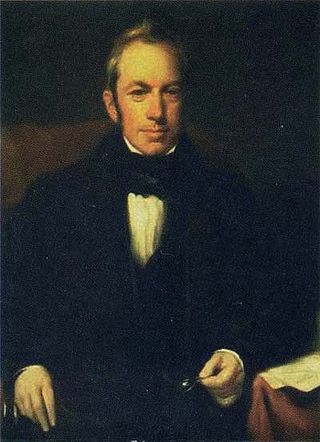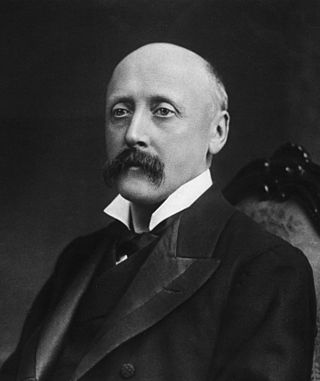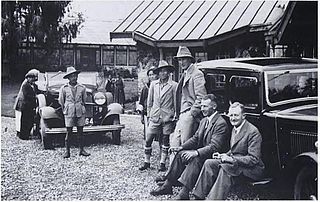
Major George Sherriff OBE (1898–1967) was a Scottish explorer and plant collector. [1]

Major George Sherriff OBE (1898–1967) was a Scottish explorer and plant collector. [1]
Born in Larbert, he was educated at Sedbergh School and attended the Royal Military Academy, Woolwich. In 1918 he took a commission in the Royal Garrison Artillery, fighting in France. After the close of the First World War, in which he was injured, he was posted to Nowshera, then in British India, during the Waziristan campaign of 1919–1920. [2] From 1927 to 1931 he served as the British vice-consul in Kashgar, Chinese Turkestan, under the consul general Frederick Williamson. [3]
In Kashgar he met the naturalist Frank Ludlow, and between 1933 and 1938 the two made several expeditions into the Himalayan regions of Tibet and Bhutan, collecting thousands of specimens, many of which were new to science. He joined the Indian Army on the outbreak of the Second World War, serving in Assam. In 1943 he was appointed to lead the British Mission in Lhasa, taking over from Ludlow. The two men undertook further plant hunting expeditions in remote parts of Tibet, with their last expedition to Bhutan in 1949. Many of the specimens collected by Sherriff are held in the Natural History Museum in London.
In 1947 Sherriff was appointed OBE, and in 1948 was awarded the Royal Horticultural Society's Victoria Medal of Honour. [3] On returning to Britain in 1950, he bought the estate of Ascreavie in Angus, where he cultivated a collection of Himalayan plants, described as having "outstanding horticultural value". [4] He served on Angus County Council from 1952 to 1966.
Sherriff's papers are held by the Royal Botanic Garden of Edinburgh. [5]

Robert Brown was a Scottish botanist and paleobotanist who made important contributions to botany largely through his pioneering use of the microscope. His contributions include one of the earliest detailed descriptions of the cell nucleus and cytoplasmic streaming; the observation of Brownian motion; early work on plant pollination and fertilisation, including being the first to recognise the fundamental difference between gymnosperms and angiosperms; and some of the earliest studies in palynology. He also made numerous contributions to plant taxonomy, notably erecting a number of plant families that are still accepted today; and numerous Australian plant genera and species, the fruit of his exploration of that continent with Matthew Flinders.

The Royal Botanic Garden Edinburgh (RBGE) is a scientific centre for the study of plants, their diversity and conservation, as well as a popular tourist attraction. Founded in 1670 as a physic garden to grow medicinal plants, today it occupies four sites across Scotland—Edinburgh, Dawyck, Logan and Benmore—each with its own specialist collection. The RBGE's living collection consists of more than 13,302 plant species, whilst the herbarium contains in excess of 3 million preserved specimens.

Henry John Elwes, FRS was a British botanist, entomologist, author, lepidopterist, collector and traveller who became renowned for collecting specimens of lilies during trips to the Himalaya and Korea. He was one of the first group of 60 people to receive the Victoria Medal of the Royal Horticultural Society in 1897. Author of Monograph of the Genus Lilium (1880), and The Trees of Great Britain & Ireland (1906–1913) with Augustine Henry, as well as numerous articles, he left a collection of 30,000 butterfly specimens to the Natural History Museum, including 11,370 specimens of Palaearctic butterflies.
George Don was a Scottish botanist and plant collector.

James Drummond was an Australian botanist and naturalist who was an early settler in Western Australia.

Sir Isaac Bayley Balfour, KBE, FRS, FRSE was a Scottish botanist. He was Regius Professor of Botany at the University of Glasgow from 1879 to 1885, Sherardian Professor of Botany at the University of Oxford from 1884 to 1888, and Professor of Botany at the University of Edinburgh from 1888 to 1922.

Frank Ludlow OBE was an English officer stationed in the British Mission at Lhasa and a naturalist.
Reginald John Farrer, was a traveller and plant collector. He published a number of books, although is best known for My Rock Garden. He travelled to Asia in search of a variety of plants, many of which he brought back to England and planted near his home village of Clapham, North Yorkshire.

Ascreavie is a country house in Angus, Scotland. It is located 2 kilometres (1.2 mi) north of Kirkton of Kingoldrum, and 6 kilometres (3.7 mi) north-west of Kirriemuir. The farms of Over Ascreavie and Nether Ascreavie lie close by. In 1987 the gardens at Ascreavie were added on the Inventory of Gardens and Designed Landscapes in Scotland for its important horticultural collection, gathered by the plant-hunter George Sherriff. They were removed from the inventory in 2017.

James Herbert Veitch F.L.S., F.R.H.S., was a member of the Veitch family who were distinguished horticulturists and nursery-men for over a century.

George Forrest was a Scottish botanist, who became one of the first western explorers of China's then remote southwestern province of Yunnan, generally regarded as the most biodiverse province in the country.

Buddleja tibetica was a species sunk as Buddleja crispa by Leeuwenberg in 1979, and treated as such in the subsequent Flora of China; however, the plant remains widely known by its former epithet in horticulture.
Sir George Taylor, FRS FRSE FLS LLD was a Scottish botanist.

Thomas Drummond, was a Scottish botanical collector.

Botanical expeditions are scientific voyages designed to explore the flora of a particular region, either as a specific design or part of a larger expedition. A naturalist or botanist would be responsible for identification, description and collection of specimens. In some cases the plants might be collected by the person in the field, but described and named by a government sponsored scientist at a botanical garden or university. For example, species collected on the Lewis and Clark Expedition were described and named by Frederick Traugott Pursh.

Frederick Williamson (1891–1935) was a British Political Officer stationed in Sikkim, Bhutan, and Tibet in the 1930s. He was also an explorer and a founding member of the Himalayan Club. It was 'largely owing to his influence and the esteem in which he was held in Lhasa' that Tibet permitted the 1935 and 1936 Mount Everest Expeditions. His life was cut short by a chronic illness which occurred in Lhasa during November 1935 on a mission to negotiate a settlement between Tibet and Thubten Choekyi Nyima, 9th Panchen Lama. On the announcement of his death, the Government of India stated that 'it robbed the Government of a most valuable officer'.
Roland Edgar Cooper FRSE FRSGS was a British botanist and Curator of the Royal Botanic Garden Edinburgh from 1936 to 1950. Within the Gardens the Roland Edgar Cooper Collection stems from his own work. A number of species found by him bear the name Cooperi. A large number of Rhododendrons collected by Cooper continue to grow in the Gardens.
Sir Frederick Claude Stern was a botanist and horticulturalist, known for developing the gardens at Highdown Gardens, for creating several cultivars of garden plants and for his publications on peonies, snowdrops and gardening. He also tried to promote the interests of the Jewish community.
Lilium sherriffiae is a species of Lilium native to Bhutan and Nepal in southeastern Asia.
Dorothy Graham Renton was a Scottish gardener noted for creating Branklyn Garden in Perth with her husband John. She took the Veitch Memorial Medal for her work in 1954 from the Royal Horticultural Society. Branklyn was described as "the finest two acres of private garden in the country". It is owned by the National Trust for Scotland.